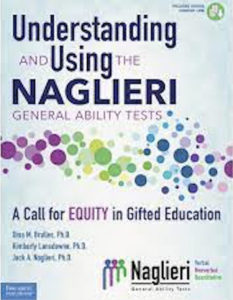Equitable Naglieri Tests Can Help ID Gifted Kids
Understanding and Using the Naglieri General Ability Tests: A Call for Equity in Gifted Education
By Dina Brulles PhD, Kimberly Lansdowne PhD and Jack A. Naglieri PhD
(Free Spirit Publishing, 2022 – Learn more)
Reviewed by Kim Rensch

Where some school districts have thrown out the proverbial baby with the bathwater by “fixing” the problem of equity through elimination of gifted and talented programs, others have sought to bring equity to existing programs through alternative identification tools.
Developed in 2003 by Dr. Jack Naglieri (a co-author of this book), the Naglieri Nonverbal Ability Test offers an alternative to traditional academic testing, opening doors to gifted programming that had once been closed to so many.
Dr. Naglieri and his co-authors have published a comprehensive guide not only to using the Naglieri General Ability Tests, but also to delivering instruction to those students identified through the tests for gifted services.
Part One: Measuring General Ability

I found this introductory section of the book to be persuasive, with common sense assertions like “…tests relying on questions that measure knowledge confound the measurement of general intelligence” (13) and “Tests that demand knowledge are more difficult for students who have less background knowledge and/or emerging English-language skills, and the result is lower scores” (21).
While these assertions are supported by study results referenced in chapter two, readers are sure to notice that the studies were co-authored by Dr. Naglieri himself. It is likely, therefore, that some readers will desire study results from independent researchers.
Nonetheless, this initial section of the book is sure to provide a nudge in the direction of considering nonverbal tests of general ability as a means for gifted and talented identification.
Part Two: Administering and Interpreting Ability Tests
As the title suggests, the heart of the book is devoted to the nuts and bolts of test administration and results interpretation. Chapter 4, “Understanding and Using Test Scores,” will likely be the most useful of all the chapters here. The authors provide advice for using the Naglieri General Ability Tests as screeners versus identification tools, as well as for calculating norms once tests are administered.
The authors also provide case study descriptions to guide school staff in interpreting scores and determining placement in gifted and talented programming. This middle section of the book is thorough enough to make the process of implementing the Naglieri General Ability Test less complicated for someone new to decipher.
Beyond Testing
The third section of this book is titled “Instructional Approaches.” Here, I had anticipated a collection of instructional strategies that teachers might employ when working with their newly-identified gifted children. But this is not exactly what I found.
Despite its confusing title, though, the section is still a practical read. It is broken into two chapters, both arguably more aptly named than the section they comprise. The spirit of Chapter 5, entitled “The Next Step: Achieving Equity in Gifted Programming,” could best be captured by this line from page 73:
To make necessary progress, schools and districts need to identify the patterns, beliefs, and assumptions that are the foundation of their current programs and services.
School districts looking to shift staff thinking around serving ALL students will find this a useful chapter. The authors identify a long list of district departments that need to collaborate in order to “assist in establishing equitable and sustainable gifted education services throughout the school system” (88).
They also challenge school personnel to examine their gifted programming and policies to ensure their practices meet the needs of their diverse body of learners. Chapter six rounds out the book with a call for culturally responsive teaching. Educators will likely appreciate the examples of discipline-specific culturally responsive practices featured in this chapter.
A Call to Action
After three in-depth sections, the book ends with a page-long “final note.” It’s a powerful call to action, reminding all educators that we must “recognize each student’s potential and ensure they receive an equitable and appropriate education” (124). This comprehensive guide to the Naglieri General Ability Tests is sure to facilitate a smoother journey to equitable identification of students with exceptional abilities.
Kim Rensch (@KJRensch) is a National Board Certified Teacher working as a member of the Gifted Services team for Fargo Public Schools in North Dakota. She is also a Teacher-Consultant in the Red River Valley Writing Project. When she’s not doing something school-related, Kim can be found at church or spending time with her husband, their dogs, or her many plants and flowers.






























